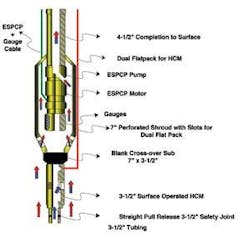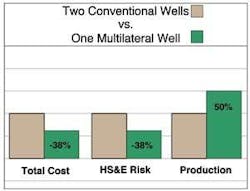Intelligent multilateral wells maximize reservoir contact
The industry’s acceptance of multilaterals and intelligent well systems (IWS) as mainstream solutions for today’s reservoirs has permitted development of marginal fields. These technologies have been applied in a variety of well profiles, from heavy oil to high pressure gas, underbalanced drilling, conventional oil wells, subsea, and deepwater.
Mukhaizna field example
Petroleum Development Oman (PDO) discovered the Mukhaizna field over 25 years ago and began oil production on June 30, 2000. Production was heavy oil with a viscosity of 14-16°API, (1,500-2,000 mPa.s in-situ viscosity). The two oil-bearing sandstones found in this field contained 374 MMcm of reserves. The technical difficulties of heavy oil in unconsolidated sand with the probability of water breakthrough resulted in high field development cost. The operator’s use of horizontal multilateral wells was a cost-effective way to maximize recovery and lower the cost per barrel produced. In 2000, the field was steam injected and currently produces 2,000 cm/d from 52 single and 4 dual horizontal wells. The multilateral systems allow for either jointed work strings or coiled tubing re-entry into both the lateral and the main bore. Additionally, the system accommodates commingled production to an electric submersible PCP pump. The operator controlled the production from the Middle Gharif using a hydraulically operated sliding sleeve. Later, the company initiated artificial lift. Initial results showed minimum vibration of the ES-PCP assembly at less then 1G where 5Gs were expected.
Glitne field example
Statoil discovered the Glitne oil field in 1955 in blocks 15/5 and 15/6 in the Sleipner area of the Norwegian North Sea, about 40 km (25 mi) northwest of Statoil’s Sleipner East development.
The water depth in the area is approximately 110 m (361 ft). Statoil brought the field onstream at the end of August 2001 with daily production set to plateau at 40,000 bbl.
The subsea Glitne field produces 25,000 b/d of oil from five producers with one water/gas injector. The operator decided to use multilateral technology to increase production. This technology enabled the operator to drill two laterals in a new section of the reservoir from a common wellbore, plus gain reservoir and production data. The service company’s system has a corrosion resistant alloy reformable junction and compatible with gravel packs and a 9 5/8 in. casing/completion program. This system has a 7 in. top connection with 2 x 5 in. legs - one is preformed - that is deployed in 9 5/8 in. casing and then reformed in the casing window. The operator drilled laterals in the sandstone reservoir and completed with sand control screens. To selectively produce and/or control water production from the laterals, the operator selected the intelligent well completion system with selective zonal production and injection without the need for well intervention. The sliding sleeve can be shifted open or closed by applying hydraulic pressure through a single hydraulic control line routed from the surface.
TAML levels
The industry’s TAML (Technical Advancement of Multilaterals) Level 1 multilateral is an openhole lateral from an openhole mother bore with no mechanical or hydraulic junction. This level usually is applied in consolidated formations as barefoot completions (generally in coterminous formation structures). The industry’s Level 1 multilateral completion has been widely applied in the United States, Canada, Europe, and the Middle East, with up to six laterals drilled from the mother bore. Based on experience, the industry uses external casing packers and PIPs to provide an anchor point for whipstocks. An orientation sleeve provides whipstock orientation. While, lateral entry nipples allow selective reentry for remedial work in Level 1 laterals after they have been placed on production.
Many operators’ traditional Level 1 fields are being converted to Level 2 because of the difficulties often associated with level one.
The TAML Level 2 multilaterals, in which the mainbore is cased and cemented and the lateral bore is open, give more flexibility than Level 1. Operators acknowledge that the junction and completion of a Level 2 is economical, permitting selective production, and is available in most casing sizes. Operators deploy Level 2 in standard vertical wells and in highly deviated (60°-90° angles) and under balanced drilling applications. Operators using Level 2 technology with retrievable whipstock systems, liner hangers, lateral entry nipples casing locating profiles (SLOPE), and packers with modified mechanical setting mechanisms realize effective junctions are created with production isolations and full re-entry capabilities. Through-tubing access to either lateral is an effective means of intervention without extensive workover.
In a Level 3 multilateral, the main bore is cased and cemented, and the laterals are cased but not cemented. Early Level 3 multilateral completions used a flow-through guide stock and slotted liner or screen straddling the junction window and main bore, and anchored back by a liner hanger. This provides little functionality, since a liner anchored back to the main bore limit reentry to only the lateral. The Hook Hanger system introduced in 1999 marked a significant step in the development of cost-effective, fit-for-purpose multilateral solutions. The Hook Hanger system provides mechanical support for junctions that join cased and cemented main bores the lateral liner.
Using a Level 4 multilateral, operators case and cement both the main bore and laterals for mechanical junction integrity. Any system using milling or wash over to achieve access to the lower lateral should be avoided. These methods of creating a Level 4 junction add unnecessary risk and jeopardize the well. There are low-risk simple solutions for Level 4 junctions. These systems are as easy to deploy as a common liner.
The multilateral Level 5 hydraulic isolated junction is necessary to manage the reservoir and to handle complex geology wells with multiple pressures, fluids, and rock strata. However, the operator’s multilateral wells junction point cannot be exposed to production.
In a Level 5, full hydraulic pressure and mechanical integrity (often achieved by starting with a Level 4 junction) at the junction with the completion is achieved. Pressure integrity is accomplished using single packers in each lateral, a packer in the main bore above the junction, and with tubing string in each lateral (Note: A Level 2 “plopped and dropped” cemented liner also can be used to upgraded to a Level 5). The first Level 5 multilateral was completed in the Gulf of Mexico in 1995. Since then, several Level 5 junctions have been installed through out the world. Level 5 wells offer significant potential functionality for effective junction isolations.
The industry defines a TAML Level 6 multilateral as one in which junction pressure integrity is achieved with the casing. In a Level 6 well, the entire junction is an integral part of the main casing string. In the first Level 6, the formation junction reformed downhole using swaging technology. Operators acknowledge that Level 6 junctions are most effective in injections wells.
Intelligent wells
Intelligent well systems offer more flexible management of hydrocarbon assets. By combining real-time data monitoring with surface-controlled sliding sleeves, an operator can reduce or eliminate interventions and their associated risks, reduce production downtime, and lower overall well operating costs. This allows operators to control multiple production or injection intervals independently without extended reach, multilateral, and subsea wells. The operator can select total shut-off or rate control of undesirable water or gas encroachment in a producing well, as well as total shut-off or infectivity rate control of a selected interval in an injection well. Additionally, the operator can perform real-time monitoring of downhole pressure, temperature, and flow which enables:
- Dynamic tubing pressure measurement at or near perforation depths
- Sandface pressure determination with no wellbore storage effects
- Selective interference and transient pressure testing.
Currently, intelligent well systems for remote control and permanent monitoring include:
- Hydraulically-based system with electronic permanent downhole gauges
- Hydraulically-based system with fiber-optic sensors
- All-electric intelligent completion system.
Hydraulic intelligent completion systems use sliding sleeves actuated by hydraulic pressure. Sleeves can be opened, closed, or placed at various positions by applying surface pressure to the corresponding control lines in the appropriate sequence. In hydraulic systems, downhole gauges permanently deployed as a separate module collect real-time pressure, temperature, and flow rate data. Communication between the gauge and the surface data acquisition unit can be monitored through separate control line(s) containing a mono conductor. A fiber-optic system can be run in place of an electric permanent downhole gage.
All-electric systems
All-electric intelligent completion systems combine electrically actuated sliding sleeves with electrical sensors. Each valve is an infinitely variable choke driven by an electric motor and monitored with integrated electronic sensors. Electrical power and addressable digital signals travel through a common epoxy-filled twisted pair conductor to all the valves in the well. Upon addressing a particular valve, the electrical power drives a motor to adjust the position of the sleeve to control flow.
In March 2003, these two systems were applied in the Mukhaizna field onshore Oman. A horizontal multilateral well was chosen because of its cost effective method of completion that would allow for commingled heavy oil production through an electric submersible PCP pump. The option to shut off production from the mainbore in the event of anticipated water breakthrough is achieved by closing the HCM remotely from surface. Once water coning has dissipated, production from the lower leg can be initiated by opening the HCM again from surface. This reduces cost because it eliminates shutdown of production from the lateral leg and rig down time associated with manipulation. It also reduces risk associated with intervention activities.
A Level 5 in conjunction with an IWS was installed in the Giltne field in the Norwegian sector of the North Sea in June 2004. This system was selected to provide a mechanical support with hydraulic isolation at the junction that was compatible with gravel packs and 9 5/8 casing/liner completion using corrosive resistant alloys. The operator required selective production and /or control water production form the laterals.
Editors Note: This article is a summary of the paper prepared for presentation at the 2006 Offshore Technology Conference held in Houston, Texas, U.S.A., 1-4 May 2006.
Barton Sponchia
Brent Emerson
John Johnson
Baker Oil Tools



